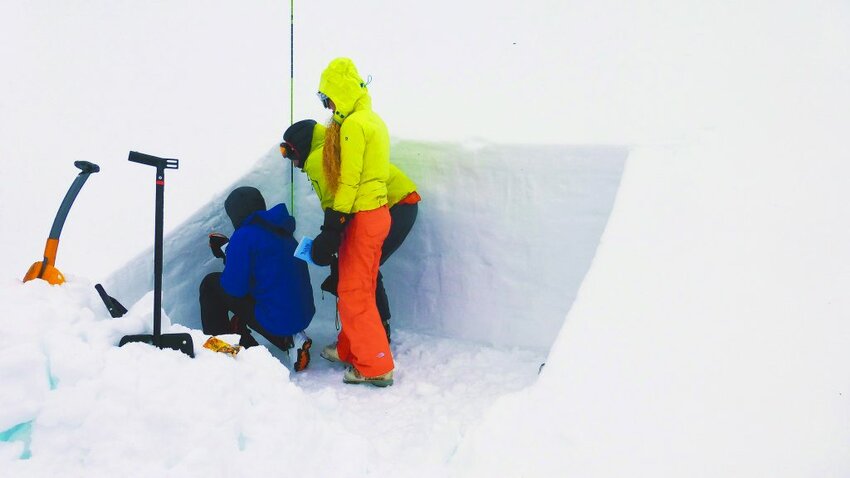 Students analyze layers in a snowpit. Photo courtesy of John Minier.
Students analyze layers in a snowpit. Photo courtesy of John Minier.For years, backcountry skiers and snowboarders with some avalanche training and a desire to learn more about the subject had a lack of options. For most recreational skiers with an American Institute for Avalanche Research and Education (AIARE) Level 1 course, the next option was an AIARE Level 2 course. That course tried to serve recreational backcountry travelers and aspiring avalanche professionals – guides, patrollers and avalanche forecasters – making it difficult to meet either group’s needs.
Big changes to avalanche education start this year. The long awaited professional-recreational split has arrived. With input from avalanche educators, the American Avalanche Association created new standards that reflect the split in recreational and professional avalanche education.
The new AIARE Level 2 course has an emphasis on touring and decision-making that is more applicable for recreational backcountry travel. Aspiring avalanche professionals also get new curriculum that focuses on their needs, with more snow science.
Professional vs Recreational Goals
Recreational backcountry travelers and avalanche professionals often have different goals requiring different skills. Aspiring avalanche professionals need to be able to forecast, track and manage avalanche hazards in the context of a ski area, guided group or other operation. For them, it’s vital to learn the science of avalanche formation and release, snowpack metamorphism and meteorology. Professionals need well-developed observational techniques and recording methods that adhere to industry standards.
While these skills can help any backcountry traveler, they take years to become useful in the decision-making process and aren’t the most important thing for a recreational backcountry traveler.
The average backcountry skier or snowboarder wants to better identify avalanche terrain, track avalanche problems, estimate consequences and mitigate hazards through terrain choice and decision making – things that don’t require an advanced snow science course.
Getting Started
As before, anyone who wants to ski in avalanche terrain should start with the AIARE Level 1 avalanche course. The AIARE Level 1 offers a comprehensive introduction to avalanches, observational and decision-making techniques, terrain assessment and companion rescue. From there, continuing avalanche students must make a decision.
Recreational Avalanche Training
Recreational backcountry travelers have often wondered if a level 2 avalanche course is worth the time and cost. The answer now is yes. The recreational level 2 curriculum focuses less on standardized observations and recording methods. This frees up more time for touring, informal observations, group decision making, and of course, skiing and riding.
The new course is three days instead of four. Avalanche rescue is now a stand-alone course rather than part of the curriculum. The AIARE Avalanche Rescue Course is a prerequisite for the new AIARE Level 2 certificate, so in effect, completion of the level 2 still requires four days of training.
The new AIARE Avalanche Rescue Course can be taken independently, but many providers will offer one immediately before the AIARE Level 2. The new AIARE Avalanche Rescue course will allow for a full day of advanced companion rescue training and include many opportunities to practice multiple-burial search techniques.
Professional Avalanche Training
Students will begin their professional avalanche education with the Professional Avalanche Training 1 course (Pro 1). The AIARE Level 1 and the AIARE Avalanche Rescue Courses are prerequisites for the Pro 1. The curriculum is similar to the old AIARE Level 2, but allows more time for students to develop their standardized observational skills, recording methods, and operational decision-making. The Pro 1 is five days long, concluding with an examination.
Aspiring avalanche professionals will complete their training with the Professional Avalanche Training 2 course (Pro 2). The AIARE Pro 2 is designed to prepare students for a leadership role in an operational avalanche program. The Pro 2 replaces the old AIARE Level 3.
Find Your Course
Anyone interested in the backcountry should attend a free avalanche awareness clinic. The Northwest Avalanche Center holds awareness clinics throughout the Pacific
Northwest.
Skiers and snowboarders who plan on regular backcountry travel should consider completing the entire recreational training program. Many guide services throughout the Northwest offer the AIARE Level 1, AIARE Avalanche Rescue Course, and AIARE Level 2. AIARE and the Northwest Avalanche Center maintain a list of local providers and courses.
Aspiring avalanche professionals should sign up for pro courses directly through AIARE. Pro courses are offered in venues around the country, and taught by AIARE’s in-house pro instructors.
Above all, invest the time and money to get educated. Here’s to another safe and successful season in the backcountry. We’ll see you out there.
John Minier is owner and lead guide at Baker Mountain Guides. Originally from Alaska, he has a deep appreciation for wild and mountainous places. After moving to the lower 48 some 20 years ago, his passion led him to guiding and outdoor instruction. Since 2004, he has worked across the western U.S. as a rock guide, alpine guide, ski guide, and avalanche instructor.